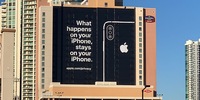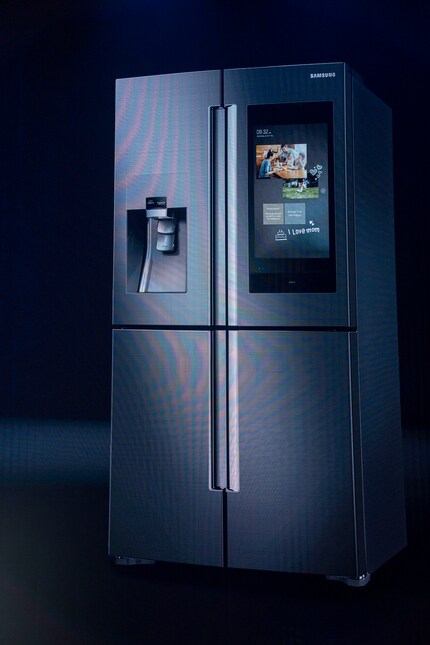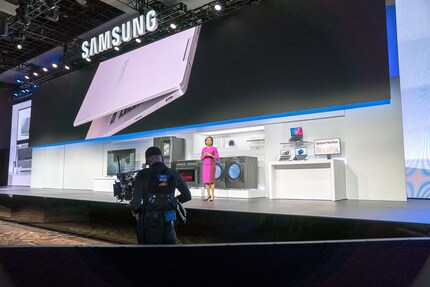
Background information
Smart TV vs. privacy: How Apple and Samsung share data
by Dominik Bärlocher

At the official press conference at CES Las Vegas, Samsung showed how the company envisages 2019 and the near future. From washing machines and televisions to laptops, exoskeletons and robots, everything is to be connected by Bixby.
Less than 24 hours after the unofficial and somewhat informal press conference in Las Vegas, Samsung invites you to the official media event at Mandalay Bay. The hotel and casino complex, which has 3209 hotel rooms, will host talks and conferences during the CES days. One day before the trade fair, however, the entire Mandalay Convention Halls are booked for press conferences organised by large corporations.
Journalists from all over the world gather in front of the stage before the press conference. Photographers and cameramen are looking for the best view of the stage and a spotlight dazzles those typing their first lines on their laptops.
Pounding bass booms out of the speakers. The lettering on the gigantic screen shows Samsung's technological evolution. The company is proud to have been helping people around the world for 50 years. Samsung's President and CEO H. S. Kim takes the stage. Thunderous applause from the journalists. The man in the black suit and glasses talks about five decades of Samsung, looks back at the company's first product, a black-and-white television, and looks forward.
"In 2019, we will take technology to the next level," he says.
Devices, connectivity and intelligence are what characterise not only Samsung, but also its users. Because Samsung doesn't just make a few smartphones, it offers end-to-end solutions in the smart sector. SmartThings, including an app for smartphones, not only connects the internet to phones, televisions and other devices, but also to your fridge, washing machine and probably even your toaster.
Kim speaks publicly about 5G for the first time since MWC 2017. The new wireless data transfer standard is set to bring gigabit synchronisation. Samsung is one of the pioneers of this technology. In only slightly accented English, Kim reports on the advances in the USA. The FCC, the broadcasting regulatory authority, has approved 5G on mobile devices. This is exciting because the Samsung Galaxy S10 is rumoured to be a fully 5G-capable smartphone.
"We will launch 5G smartphones this year," says Kim.
The Galaxy S10?
"Artificial intelligence is instrumental to our vision of the future," says Kim. The company is therefore consolidating all its efforts in the direction of artificial intelligence (AI) in the Bixby project. What was once just a simple voice assistant will one day become a fully functional and inclusive AI platform. As this poses major risks for users, data and privacy, the company has written three words on its banner to prevent the worst from happening.
Bixby's algorithms are designed to be open. Where there is an open API - in other words, an interface - Bixby should be able to hook in. It should soon be possible to order Uber taxis, buy concert tickets via Ticketmaster and even talk to YouTube and other Google products. Bixby will also optimise content. The picture on the 8K TV, for example. Or the sound on other devices.
The year 2019 should be the year in which users see Samsung's vision come to life.
"Over 70 per cent of households in the USA have at least one Samsung device in the home," says Yoon Lee, senior vice president Samsung America.
This is all well and good, but Samsung is also set to make inroads into the business sector. The company has been trying to do this for some time; the Note series has a desktop mode that turns your smartphone into a PC.
But that's not enough for Samsung. AI will be available in more devices in 2019. Dave Das, Senior Vice President of Samsung, takes the stage. He talks about televisions that blend seamlessly into the interior design of your home. But that's not the company's big success. Samsung is proud of Micro-LED. The new screen technology should deliver even better pictures. The screen technology is designed to break away from the rectangular form factor, as a micro-LED TV consists of individual borderless panels that can create any shape and a resolution of up to 10k.
However, Dave Das is not showing a micro LED TV, because the 8K TV is getting a new size. The new size is up to 98 inches diagonally. That's about 250cm. Dave Das looks comparatively small next to the QLED device. The device should support HDMI 2.1 and offer a pixel-free picture via AI upscaling, even if the original picture has a lower resolution. Incidentally, upscaling takes place in real time.
The images are optimised in collaboration with major providers such as Amazon and new data standards are sought. This is because Amazon has created a format with its own streaming service, Amazon Prime, which is intended to bind customers to the Amazon shop via a plan. The big question with video files, however, is bandwidth and compression. Because if you want to stream a film in 8K, you need bandwidth. A lot of bandwidth. More bandwidth than some households can or want to have. Compression is therefore one of the most important aspects when transmitting image data.
Bixby also gets involved here. The AI platform is supposed to answer questions such as "Bixby, which action film should I watch today?". To do this, the assistant remembers what you have watched and liked so far and then suggests things. Somehow, this should also work with Apple's streaming service, although Samsung is said to have no direct access to Apple's data, according to industry magazine The Verge.
A small demo on stage shows how you can predefine your TV programme. The commands after the trigger "Hi Bixby" are all context-dependent. "The first one" or "Show me something that's like what I was watching yesterday". The assistant even understands complicated sentence constructions in English. Even if the AI's female voice seems a little choppy - Siri speaks more fluently in standard languages - the programme understands almost natural language.
John Herrington, Senior Vice President Samsung US, takes the stage. Behind him on the screen is a refrigerator. The contents of the Family Hub can be seen on the screen of a Samsung refrigerator. Weather reports, calendars, pictures, shopping lists and all sorts of other things can be displayed. The functions are shown in an emphatically harmonious advertising clip with soft indie pop music in the background. Music can be played throughout the house and messages can be exchanged. Imagine it like a mobile phone screen, just bigger and in a refrigerator door.

The refrigerator is just one of many Samsung products that will be connected through the Bixby platform. All devices will be automatically updated to the new version of Bixby.
Bixby should also think for itself. When Herrington talks about the washing machine, he mentions that the washing machine remembers when you do what and suggests washing cycles accordingly. The washing should be ready when you enter your home, even if you have forgotten to set the washing. Bixby should even be able to make suggestions on how you should wash.
The presentation at the press conference seems to go round in circles. A device is shown, then someone talks about and with Bixby. It's clear where Samsung is going.
It only gets exciting shortly before the end. Alanna Cotton, Senior Vice President, presents a new 2-in-1 laptop. The Samsung Notebook 9 Pro impresses with a fully rotatable screen and a design that emphasises edges and grooves. If you still have a Samsung Galaxy S5, then you can imagine it as something like this, simply in laptop form and less rounded. Plus a new stylus that should be fully compatible with the Note series S-Pen.

The Notebook 9 Pro will be available in blue and metal colour.
For gamers, the Samsung Notebook Odyssey comes with a hexa-core i7 processor and an Nvidia GeForce RTX GPU, which should make gamers happy.
Further down the line, and now it's time for the Mandalay with just a little information from the stage, is the Samsung Space Monitor. The screen is attached to a movable arm and is designed to take up as little space as possible on your table and the cables are also supplied in the arm.
Samsung is also making its way into cars. The Digital Cockpit is set to bring smart living behind the wheel. Cars will be compatible with Dex, Samsung's desktop mode. This should make it possible to work even in traffic jams. The Digital Cockpit memorises your vehicle settings and those of other drivers. Seat height, steering wheel position and headrest. And you can check the parking situation at your destination before you set off. Thanks to 5G and vehicle-to-everything communication, this should be possible.
Exactly which cars will be equipped with the new Cockpit will not be revealed at the press conference. But that the AI Bixbys will not only live in the cloud. Samsung is taking a leaf out of Huawei's book and will be installing AI chips, known as neural processing units (NPU), in devices in the near future. Not only will the new generation of Exynos system-on-a-chip (SoC), the Exynos 9, be used for this purpose, but also in a chip that has only been developed for cars, called Exynos Auto.
It gets exciting, because the words "One More Thing" are uttered on stage. The S10? The Galaxy F? No, because Samsung bots, artificially intelligent robots and exoskeletons, are set to conquer the world. Not in the form of a robot apocalypse, but in the form of assistants that are mobile and don't appear to have death lasers built in. The white, vaguely cone-shaped thing with blinking eyes on the screen is supposed to follow you around and help you in your everyday life. Probably in preparation for the imminent extinction of humanity, Samsung Bot Care can read your blood pressure and other bio-data.
The press conference ends. No Galaxy S10, no Galaxy F.
So, that's it. I apologise for the allusions to the apocalypse.
You can find all articles on CES 2019 here.
Journalist. Author. Hacker. A storyteller searching for boundaries, secrets and taboos – putting the world to paper. Not because I can but because I can’t not.
From the latest iPhone to the return of 80s fashion. The editorial team will help you make sense of it all.
Show all